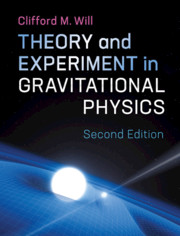Book contents
- Frontmatter
- Dedication
- Contents
- Preface
- Acknowledgments
- 1 Introduction
- 2 The Einstein Equivalence Principle
- 3 Gravitation as a Geometric Phenomenon
- 4 The Parametrized Post-Newtonian Formalism
- 5 Metric Theories of Gravity and Their Post-Newtonian Limits
- 6 Equations of Motion in the PPN Formalism
- 7 The Classical Tests
- 8 Tests of the Strong Equivalence Principle
- 9 Other Tests of Post-Newtonian Gravity
- 10 Structure and Motion of Compact Objects
- 11 Gravitational Radiation
- 12 Strong-Field and Dynamical Tests of Relativistic Gravity
- References
- Index
3 - Gravitation as a Geometric Phenomenon
Published online by Cambridge University Press: 07 September 2018
- Frontmatter
- Dedication
- Contents
- Preface
- Acknowledgments
- 1 Introduction
- 2 The Einstein Equivalence Principle
- 3 Gravitation as a Geometric Phenomenon
- 4 The Parametrized Post-Newtonian Formalism
- 5 Metric Theories of Gravity and Their Post-Newtonian Limits
- 6 Equations of Motion in the PPN Formalism
- 7 The Classical Tests
- 8 Tests of the Strong Equivalence Principle
- 9 Other Tests of Post-Newtonian Gravity
- 10 Structure and Motion of Compact Objects
- 11 Gravitational Radiation
- 12 Strong-Field and Dynamical Tests of Relativistic Gravity
- References
- Index
Summary
We describe the general characteristics of metric theories of gravity, and review the equations of non-gravitational physics in curved spacetime. We introduce the Strong Equivalence Principle, which generalizes the Einstein Equivalence Principle to situations where local gravitational interactions are important, and discuss why general relativity may be unique in conforming to this principle.
Keywords
- Type
- Chapter
- Information
- Theory and Experiment in Gravitational Physics , pp. 61 - 77Publisher: Cambridge University PressPrint publication year: 2018

